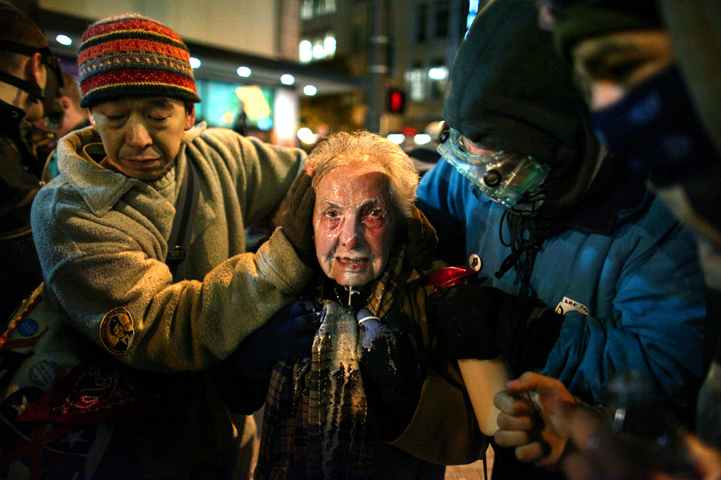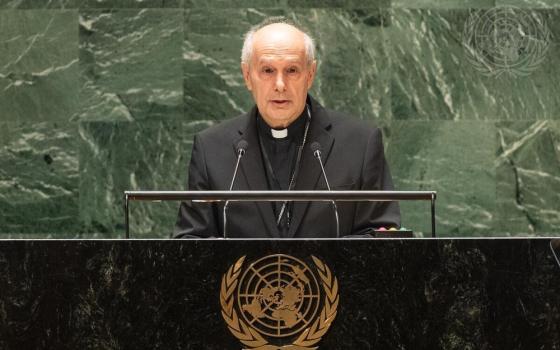
Seattle activist Dorli Rainey, 84, is helped by fellow Occupy Seattle protestors after being hit with pepper spray Nov. 15, 2011. (Joshua Trujillo)
This summer, award-winning visual journalist Joshua Trujillo will hike to the top of Mount Rainier, as he's thought about doing since moving to Seattle in 2001. Like many other Washington state residents who live and work within sight of the peak's "witnessing presence" -- as poet Denise Levertov described the mountain -- Trujillo will make the ascent with a guided tour group and a family member to mark his 40th birthday.
He'll also surely bring a camera. During a typical workday as one of two photojournalists on staff at Seattlepi.com (the scrappy online newspaper operation that carried on after the Seattle Post-Intelligencer stopped printing in 2009), Trujillo is seemingly always on the move, a necessity in the fast-paced world of breaking news.
Intent on arriving at the right place at the right time in order to capture the heights and depths of human emotion and experience through his viewfinder, he depends on social media, too, for tracking tips, posting images, and sending updates via Twitter. He is a contributor to The Associated Press, and it's not unusual for his images to appear in countless other newspapers or magazines, even occasionally sparking international attention and debate.
Yet for all of this fast-paced movement, Trujillo's photographs are arresting in their fixedness:
- The sweeping and unimaginable devastation of last year's landslide that killed 43 people near Oso, a small town about an hour north of Seattle;
- An elderly woman's uplifted face contorted by pepper spray and splashed milk during Seattle's Occupy movement (later inspiring a journalist with The Guardian to compare her to a "humiliated Christ" and an "iconic image of martyrdom");
- The silhouette of a praying woman snapped in the shadows of Seattle's St. James Cathedral shortly before Pope John Paul II's death.
Trujillo's images not only create connections between subjects and viewers, but also illumine uniquely personal narratives infused with private purpose and public meaning. There have been so many photographs taken over the years that Trujillo -- who can't help but remember every face he photographs -- will sometimes be startled by unexpected re-encounters with his work through the expressions and gestures of people passing him on the street.
Raised in a "very Catholic family" in Santa Fe, N.M., as a member of the historic Our Lady of Guadalupe Parish, Trujillo describes his life in the church at that time as "all-encompassing" and deeply community-oriented.
The son of Anthony and Mardell Trujillo (who are now affiliated with Santa Fe's San Isidro Catholic Church, where Anthony serves as deacon), Josh and his two siblings were raised to appreciate the value of family and friends, athletics, and the outdoors. Trujillo and his brother were both altar servers, and as middle school students became charter members of a youth group founded and led by their father (who remains active in youth ministry).
Anthony recalled, "Josh grew up with this, learning how to go out and help your neighbors, be a voice for the oppressed and those who don't have a voice. ... The youth group would cook a meal at church and take it to feed the people at a dining room at the homeless shelter. I would not let the kids just serve. The kids would sit down and hear their stories."
In fourth grade, Trujillo accompanied his grandparents to Europe during summer break to stay with an aunt in Germany. Just before departing, he won a competition and received a camera as the prize. A flurry of photographs throughout Western Europe followed.
During high school, he honed his photography skills through volunteering with the Santa Fe archdiocese. A growing "fascination with visually documenting faith and religion" through "sights, smells and sounds" struck Trujillo then and now as an immersive and almost poetic experience, one "that translates very well into visuals."
Trujillo attended World Youth Day in Denver as a young adult in 1993, and in 2002 covered World Youth Day in Toronto as a reporter for the Houston Chronicle.
Noting the timeless quality of so many churches and celebrations within the Catholic tradition, he would remain connected to his faith community in Santa Fe, even after moving away from the area to follow the call of his photojournalism career. Trujillo's childhood church, the Santuario de Nuestra Señora de Guadalupe, would later serve as the centuries-old backdrop for his wedding to his wife, Lina, and eventually the baptisms of their two children.
In the summer of 2008, Trujillo participated in a pilgrimage along the El Camino Real from Mexico City to Santa Fe with a 12-foot, 4,000-pound statue of Our Lady of Guadalupe. Photographing the statue as it was completed by the artisan in her foundry, he was joined by many others in the parish community, including Gail Delgado, who recalled, "When we first laid eyes on the statue, it was an 'awe movement.' We were walking up, singing the Hail Mary in Spanish. ... The tears just started flowing immediately."
Trujillo said that journalists "can tell their best stories when they're covering something that they either have been immersed in or have a connection to. ... Moments that a viewer can identify with are when an image becomes magical."
Noting that it's "important to not bring in biases and prejudices," he speaks of the diverse cross section of society he has interacted with over the course of his career -- from hardened criminals and gang members to CEOs and professional athletes -- as well as unforgettable wartime experiences during an unexpected assignment in Afghanistan shortly after Sept. 11, 2001.
In Seattle, often cited as the "least-churched city in the country," Trujillo has nonetheless found himself at the center of major church-related events, such as a teeming, lantern-lit interfaith march between the city's Episcopalian and Catholic cathedrals to advocate for gun safety legislation in 2013.
According to Joel Connelly, longtime reporter at Seattlepi.com, Trujillo has been instrumental in covering wide-ranging stories in the region -- events such as "when Catholics for Marriage Equality put 500 people on the street outside St. James Cathedral" in 2012; Seattle's "Support the Sisters" movement that same year; and the protest by Eastside Catholic high school students last year following dismissal of their vice principal because of his civil same-sex marriage.
Connolly, describing his partnership with Trujillo as a "seamless web," also admitted, "Josh and I have the benefit/inspiration of covering some of America's least docile Catholics."
Trujillo acknowledges a link, too, between Catholic social justice teachings and his own life and work as a visual journalist. He has ridden trains and floated down rivers on makeshift rafts with undocumented immigrants at Mexico's southern border, and covered the aftermath of the Newtown, Conn., and Seattle Pacific University school shootings. Trujillo often finds himself in "situations that are either hugely uncomfortable from a personal level or situations where you always have to be an observer."
Though not the type of reporter who seeks out such stories, he admits that he has become known in the field for his coverage of particularly challenging events. "A lot of things in my day-to-day life could be considered potentially traumatizing for some people to witness," he said.
These experiences have included tragedies that were more personal, such as a helicopter crash near the Space Needle in 2014 that caused the death of the pilot and a television news journalist whom Trujillo knew. Then, four days later, the Oso landslide devastated an entire community almost in an instant.
Assigned to cover both stories, Trujillo was able to spend Sunday Mass with his family before heading to Oso.
"There is so much noise in the world and my job by nature has me wandering into the center of it all," explained Trujillo, who is a parishioner at Our Lake of the Lake in Seattle. "Coming to church on Sunday helps me to tune all that out."
Our Lady of the Lake's pastor, Fr. Tim Clark, "always has a way to distill world events and happenings into simple lessons," Trujillo said. "Sometimes that helps me to be more grounded in all that I experience."
Ministers near Oso led a "Gathering in Hope" prayer service on March 20 to remember those lost in the landslide and to pray for survivors of the tragedy one year later. Trujillo drove back to the community around that same time to be among the people and near the places he photographed in the months following the tragedy.
As on his previous visits, Trujillo pulled up to the slide area in his vintage Volkswagen van, slung his camera over one shoulder, and readied himself to document the scenes of recovery and still-evident devastation he'd encounter. Photographs from this visit juxtapose before-and-after images of the terrain.
More than any other work assignment, the experiences he was immersed in at the disaster site continue to stay with him.
"I will never forget the response from people when Catholic Community Services offered to pay funeral expenses," he said. "There were tears shed for such a generous offer. That obviously helped the families that needed help, but it also had the effect of lifting spirits."
Both on his own initiative and by invitation, he has returned to this community several times over the past year: to walk alongside community members down State Route 530 after the highway's long-anticipated reopening; to take photographs of President Barack Obama's visit with families and recovery workers and his tour of the devastation; and to spend reflective time in the area with his own family and dine at the local restaurant.
It's another kind of "witnessing presence," one that can shift from the center of an event to its periphery, from direct to subtle or imperceptible encounter. Here, just a short distance from the scarred landscape that many see as hallowed ground, stories of people who have been marked by sudden, unfathomable loss -- yet who find hope and have persevered despite injuries and suffering -- have been swept up and bound together, as recorded in Trujillo's photographs.
[Julie Gunter is a frequent contributor to NCR.]



